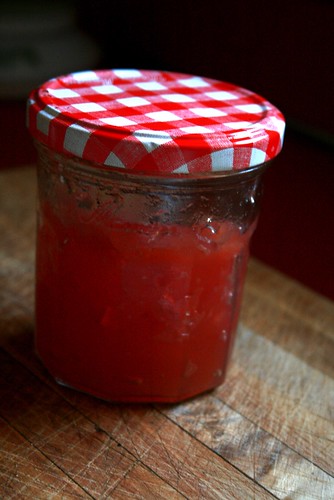
This autumn the weather has been fairly mild, meaning that a number of harvests have held out longer than usual for Kansas City. I only just pulled up my jalapeno bushes last week, and they showed no obvious signs of being finished for the season. While chili peppers are typically at their peak in August, I got my most spectacular harvests in September and October and was stuck with about 2 pounds worth of the little buggers. Normally I like to make a few batches of salsa, but this year's harvest of tomatoes wasn't that great and October isn't exactly the tomato peak at market. Another great preservation technique for chili peppers is pickling, which I find just as flavorful and useful for salsas and other Mexican dishes (even Asian, if you're so inclined). But there's only so many jars of pickled peppers you can eat in a year and only so many you can give as gifts. Eventually it's time to try new things.
This year I decided to experiment with jalapeno jelly. Last year I followed a recipe from Preserving the Harvest, which I found far too sweet when paired with the usual cream cheese. I was hoping for something more like the perfectly balanced mango-jalapeno jam I bought a couple of years ago at the City Market. Walking through the garden one day and plucking some ripe raspberries from the vine, I glanced back at the jalapeno bushes and thought of that blend of sweet and spicy and wondered if maybe this combination was worth a try. And thus, I came up with the following recipe:
Raspberry-Jalapeno Jam
1/3 cup chopped jalapenos
1/3 cup white vinegar or apple cider vinegar
1/3 cup mashed raspberries
1 teaspoon calcium water (included in box of Pomona pectin)
1/4 cup sugar or honey
1/2 teaspoon Pomona Universal Pectin
1. Mix jalapenos and vinegar in saucepan. Bring to a boil; cover and simmer for 5 minutes.
2. Stir in mashed raspberries and calcium water. In a separate bowl, stir together sugar/honey and pectin.
3. Heat vinegar mixture to boiling and add pectin/sugar mixture. Stir vigorously 1-2 minute to dissolve pectin, then bring mixture back to a boil and remove from heat.
4. Fill jars to 1/4" from top and seal. Store in fridge up to 1 month or process for 10 minutes in boiling-water bath.
My original sketch of the recipe included a homemade raspberry red wine vinegar (far better than the abortive attempt at raspberry-vanilla vodka), but I found the results a tad heavy on the raspberry. In the future I'd use a more neutral white or cider vinegar, and I've made the change to the recipe. I'm also curious whether using the jalapeno-infused vinegar is really necessary, or whether simply cooking the jam is enough to draw out the spiciness. Thoughts?
Overall, I'm pretty happy with the results of this experiment and will likely continue tweaking this recipe next year. It's quite tasty spread on wheat crackers with some cream cheese and would probably be equally good mixed with a goat cheese spread.
